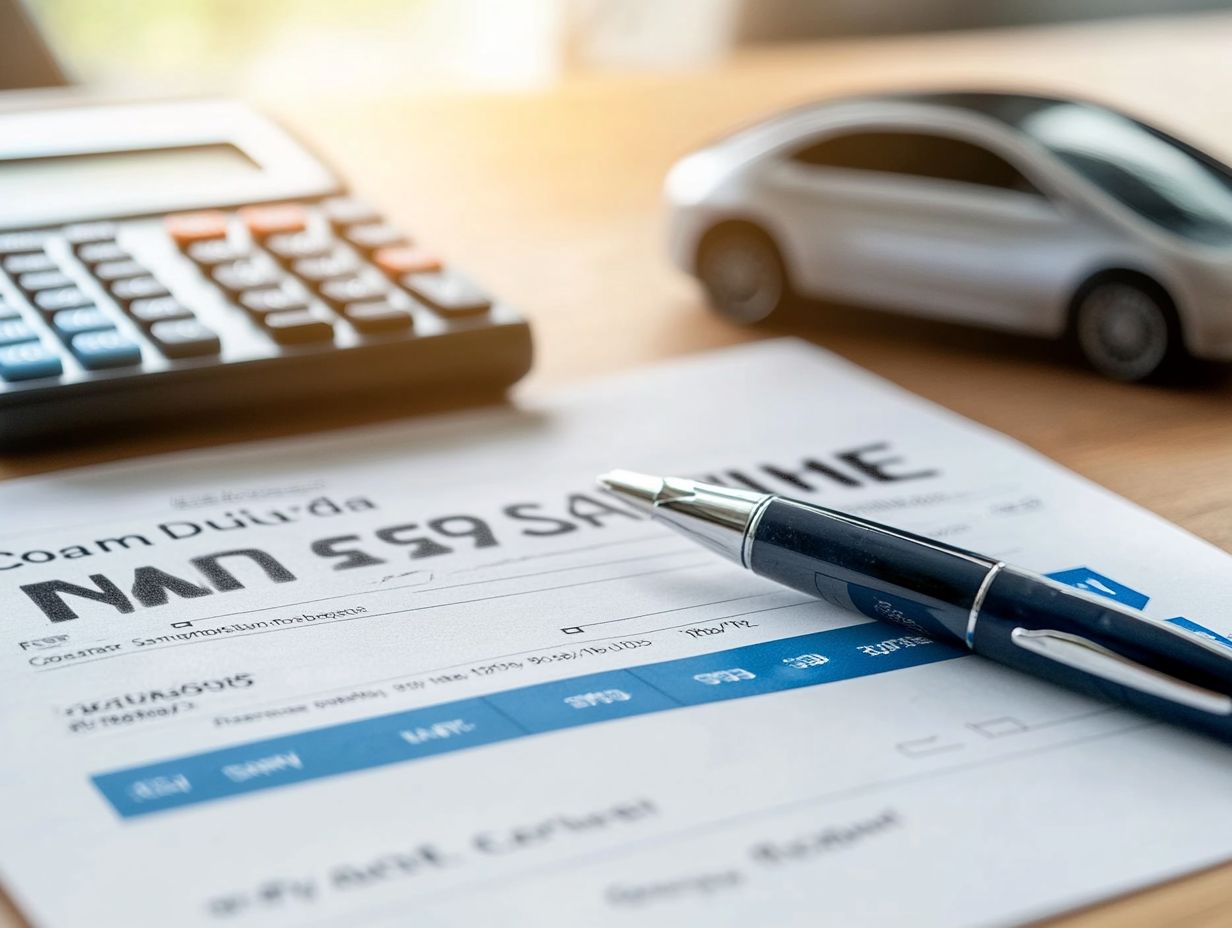How Credit Scores Affect High-Risk Driver Insurance
In today s world, grasping the intricacies of credit scores is essential, especially when it comes to securing affordable insurance rates.
This article explores the connection between credit scores and insurance, particularly focusing on high-risk drivers. You ll uncover how insurance companies evaluate credit scores, why those labeled as high-risk often face steeper premiums, and the various factors that contribute to these inflated rates.
You’ll also find actionable tips for enhancing your credit scores, along with alternative insurance options for those deemed high-risk.
Continue reading to discover how you can potentially save money on your insurance.
Contents
- Key Takeaways:
- Understanding Credit Scores and Insurance Rates
- Why High-Risk Drivers Pay More for Insurance
- Impact of Credit Scores on High-Risk Driver Insurance
- Improving Credit Scores to Lower Insurance Rates
- Alternative Options for High-Risk Drivers
- Frequently Asked Questions
- How do credit scores affect high-risk driver insurance?
- Why do insurance companies consider credit scores for high-risk drivers?
- Can a high credit score help lower insurance rates for high-risk drivers?
- What can high-risk drivers with low credit scores do to lower their insurance rates?
- Is it legal for insurance companies to use credit scores in determining rates for high-risk drivers?
- Can high-risk drivers with good credit scores still face higher insurance rates?
Key Takeaways:

- Your credit score greatly influences what you pay for insurance if you re considered a high-risk driver!
- High-risk drivers are typically those who are more likely to file a claim, leading to higher insurance premiums.
- Improving your credit score can help secure lower insurance rates, but there may also be non-traditional insurance options available.
Understanding Credit Scores and Insurance Rates
Grasping the connection between credit scores and insurance rates is crucial for any driver looking to navigate the intricate world of auto insurance with confidence.
In the current financial climate, insurance companies are placing greater emphasis on credit scores as a fundamental element of their risk assessment strategies. This reliance significantly affects your insurance premiums, shaping everything from quotes to coverage limits.
By understanding how factors like payment history, credit history, and overall financial health feed into a credit-based insurance score, you can make informed choices about your insurance policies.
What is a Credit Score?
A credit score serves as a numerical snapshot of your creditworthiness, derived from various factors such as payment history, credit utilization, and the types of credit accounts you hold.
Typically ranging from 300 to 850, this score is an essential tool for lenders in evaluating the risk of extending credit to you. For instance, a higher FICO score signals lower risk, which can open doors to more favorable interest rates and loan terms.
The calculation of your score incorporates several elements: punctual payments can significantly boost it, and it s advisable to keep your credit utilization below 30% of your available credit. A diverse mix of credit types like credit cards and installment loans can further enhance your score.
However, be cautious; applying for new credit results in hard inquiries that can temporarily lower your score, underscoring the importance of strategic credit management.
How Insurance Companies Use Credit Scores
Insurance companies leverage credit scores to assess the risk associated with potential policyholders, which significantly influences how they calculate insurance premiums and decide on coverage eligibility.
By diving into your credit history, insurers can glean valuable insights into your payment behaviors and overall financial stability. These elements are indicative of your likelihood to file a claim. This analysis becomes especially crucial during the stage when insurers decide on policies, customizing them based on perceived risks tied to different demographics.
If your credit-based insurance score is on the lower side, you may encounter elevated premiums or, in some cases, challenges in securing coverage at all.
As a result, these practices can disproportionately impact certain groups, affecting access to affordable insurance options and reinforcing financial disparities in the broader auto insurance market.
Why High-Risk Drivers Pay More for Insurance
High-risk drivers often encounter elevated insurance rates due to several factors such as a poor driving record, late payments, or significant outstanding debt. Understanding the things to know before buying high-risk driver insurance can help these drivers navigate the higher premiums imposed by insurance companies to offset potential losses tied to claims.
Therefore, understanding what categorizes someone as high-risk along with their specific liability insurance needs is crucial for effectively managing insurance expenses.
Defining High-Risk Drivers

High-risk drivers often have poor driving records. Frequent accidents and negative credit histories lead insurers to see them as more likely to file claims.
Along with a track record filled with traffic violations like speeding tickets or Driving Under the Influence (DUIs), high-risk status can emerge from consistent patterns of reckless behavior on the road. Multiple at-fault accidents, driving without insurance, and a history of license suspensions play a significant role in this classification.
Missed payments or high debt levels signal to insurers that you may struggle with managing financial responsibilities.
Finding affordable insurance can feel like a tough uphill battle, but there are ways to lighten the load! High-risk drivers often face higher premiums or limited coverage options.
However, exploring alternatives like specialized insurers or enrolling in defensive driving courses may offer some respite, helping to mitigate risks over time.
Factors that Contribute to Higher Rates
Several factors contribute to your higher insurance rates if you re classified as a high-risk driver. These include outstanding debt, a negative credit score, and a less-than-stellar driving record all of which signal to insurance companies that you may be more likely to file claims.
These elements not only reflect your financial behavior but also weave together to form a comprehensive risk profile. For example, if you have significant outstanding debt, you might struggle to pay your premiums on time, prompting insurers to raise your rates to cover potential losses.
A negative credit score, often linked to financial instability, can result in a staggering increase of up to 50% in your premiums. When you add a history of traffic violations or accidents into the mix, the cumulative effect can be overwhelming.
Some studies suggest that high-risk drivers might end up paying two to three times more than their safer peers. Therefore, showcasing financial responsibility is essential not just to lower your costs, but also to maintain a favorable standing with insurers.
Impact of Credit Scores on High-Risk Driver Insurance
Credit scores significantly influence the insurance rates applied to high-risk drivers. Insurers often view the impact of credit scores on insurance comparisons as indicators of financial responsibility, affecting not only premium adjustments but also the overall availability of insurance coverage.
How Credit Scores Affect Insurance Rates for High-Risk Drivers
For high-risk drivers, credit scores can have a significant impact on your insurance rates. Often, this results in higher premiums due to how insurers decide your rates, making it important to explore understanding high-risk driver insurance options.
Insurers consider various financial behaviors, implying that those with lower credit scores might be perceived as less responsible. This creates a correlation between financial risk and driving patterns.
As a result, many insurers use this information to categorize drivers, leading to notable differences in policy costs. If you find yourself categorized as a high-risk individual, you may face elevated rates for standard coverage options.
Some companies even offer specialized products like non-standard auto insurance or policies designed specifically for high-risk drivers, tailored to your unique situation.
By understanding these nuances, you can explore competitive alternatives or take steps to improve your credit health, ultimately helping you secure better insurance deals.
Improving Credit Scores to Lower Insurance Rates
Improving your credit score is a key strategy if you’re looking to lower your insurance rates. It requires effective debt management and maintaining a consistent record of timely payments.
Regularly reviewing your credit report to catch any inaccuracies is also essential. By taking these steps, you can position yourself for better insurance premiums.
Tips for Improving Credit Scores

To elevate your credit score, focus on building a strong payment history. Manage your credit use smartly and diversify your credit accounts to reflect a healthy financial standing.
By consistently paying your bills on time, you can significantly enhance your creditworthiness. Payment history constitutes a substantial percentage of your credit score. It s prudent to keep your credit card balances below 30% of their limits; higher utilization may indicate financial strain. For example, if you have a credit limit of $10,000, aim to keep your outstanding balance under $3,000.
Diversifying your credit accounts by incorporating a mix of credit cards, installment loans, and personal loans can demonstrate responsible credit management. These strategies boost your credit score and unlock better loan terms and insurance rates, positioning you for long-term financial stability.
Alternative Options for High-Risk Drivers
High-risk drivers frequently find themselves searching for alternative insurance options when traditional providers present them with steep rates. This prompts them to explore non-traditional insurance avenues, which often offer more accessible quotes and customized coverage tailored to their unique needs.
Non-Traditional Insurance Options
Non-traditional insurance options offer high-risk drivers coverage solutions that are often more flexible and affordable than the conventional policies provided by major insurance companies.
These innovative approaches, like usage-based insurance, customize premiums based on your actual driving behavior. This method not only encourages safer driving habits but also gives you the chance to significantly lower your costs.
Specialized products for high-risk drivers can include unique coverage features tailored to your needs, such as higher liability limits or coverage for vehicles that standard policies typically exclude.
While these non-traditional options may seem appealing due to their flexibility, they can also come with challenges, such as fluctuating premiums based on your driving patterns and limited coverage in certain situations. Make sure to carefully evaluate your situation before deciding.
Frequently Asked Questions
How do credit scores affect high-risk driver insurance?
Credit scores can play a significant role in determining the cost of insurance for high-risk drivers. Insurance companies use credit scores as a factor in assessing a driver’s level of risk and determining their premiums, which is why it’s important to look into insurance discounts available for high-risk drivers.
Why do insurance companies consider credit scores for high-risk drivers?

Insurance companies view credit scores as an indicator of responsibility and reliability. High-risk drivers with low credit scores may be seen as more likely to file claims or have a history of missed payments, making them a higher risk to insure. However, understanding how to lower your premiums as a high-risk driver can help manage costs effectively.
Can a high credit score help lower insurance rates for high-risk drivers?
Yes, a good credit score can potentially lower insurance rates for high-risk drivers. With a higher credit score, insurance companies may see the driver as less of a risk and offer them the best low-cost insurance policies for high-risk drivers.
What can high-risk drivers with low credit scores do to lower their insurance rates?
High-risk drivers with low credit scores can work on improving their credit by paying bills on time and reducing their overall debt. Over time, this can lead to a better credit score and potentially lower insurance rates.
Is it legal for insurance companies to use credit scores in determining rates for high-risk drivers?
Yes, it is legal for insurance companies to use credit scores as a factor in determining rates for high-risk drivers. However, some states have regulations in place to limit the impact of credit scores on insurance premiums.
Can high-risk drivers with good credit scores still face higher insurance rates?
Yes, other factors such as driving history and type of vehicle can also impact insurance rates for high-risk drivers. A good credit score may help, but it may not be the only factor considered by insurance companies.
Start implementing these tips today to boost your credit and save on insurance!





